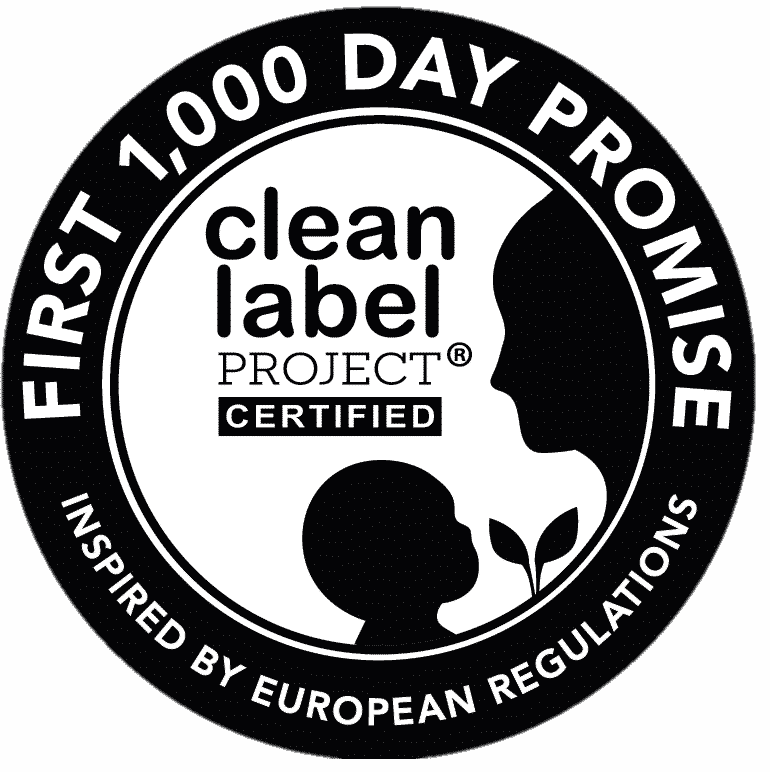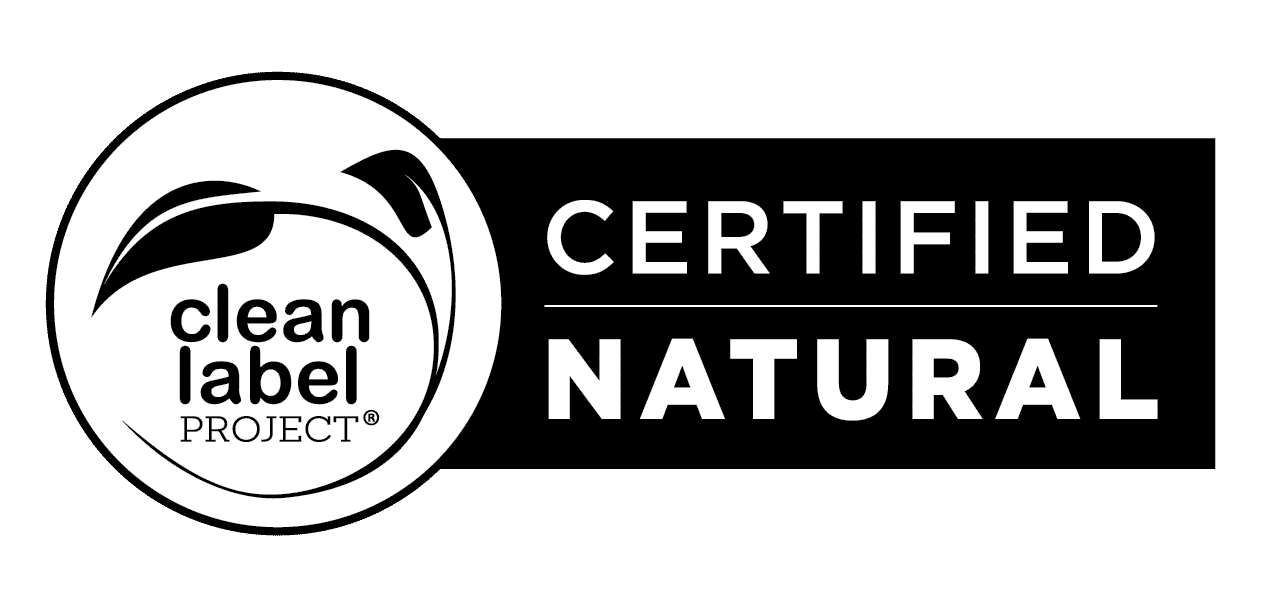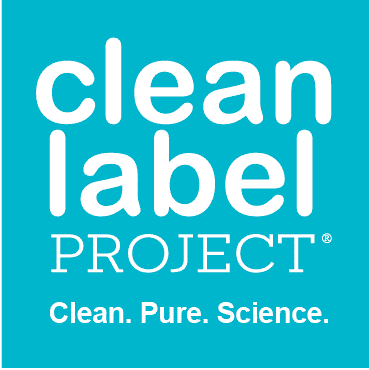Our Awards & Certifications

Clean Label Project Certification
How does it work?
Clean Label Project purchases products at retail, tests them for purity (chemicals of concern including heavy metals, pesticide residues, and plasticizers), and compares the results to high risk chemicals listed on the State of California Environmental Health Hazard Assessment Office’s Proposition 65 list. If the product is found to comply, it qualifies for Clean Label Project Certification.
STEP 1 Contact with clean Label Project
Reach out to Clean Label Project to get a non-disclosure agreement and application materials. We’ll schedule a call to discuss your brand, product portfolio, and current quality assurance and control initiatives.
STEP 2 Sampling
After the product scope is identified, Clean Label Project will use it’s Consumer Chain of Custody Sampling Process. Clean Label Project simulates the consumer shopping experience, by purchasing samples from local co-ops, national retailers, and brand websites. This independent approach to sampling is meant to mirror the consumer shopping experience and evaluate the true contents of what’s in refrigerators, drawers, and pantries across America.
STEP 3 Testing
After the products are purchased at retail, Clean Label Project submits the samples to one of it’s ISO-accredited analytical chemistry partner laboratories. The scope of testing varies depending on the product category. Testing typically includes heavy metals (Total Arsenic, Cadmium, Lead, and Mercury), over 300 of the most commonly used pesticides, including glyphosate, the active ingredient in Round-up that has been linked to non-Hodgkins lymphoma, and plasticizers (including BPA, BPS, phthalates), and other chemicals of concern. The testing process can take up to 3 weeks.
STEP 4 Analysis
Upon completion of the testing, Clean Label Project schedules a call with the testing laboratory and the brand. The test results are shared and discussed. Products that yield test results that comply with the State of California Environmental Health Hazard Assessment Office’s Proposition 65 list in addition to other supporting compliance requirements, qualify for Clean Label Project certification.
STEP 5 Ongoing Compliance
Clean Label Project will work with you on the marketing of your award to both consumers and retailers. However, keep in mind, a single test point is not enough to demonstrate ongoing compliance. It’s about making sure that the brand continues to maintain their internal quality assurance and control programs. Clean Label Project will continue to use its consumer chain of custody sampling and testing process to perform unannounced sampling and testing. The expectation is that you maintain the same ingredient quality assurance requirements to maintain these high standards.
If a product is found to be non-compliant, adverse action policies are outlined in the applicable Clean Label Project Code of Practice.

Clean Label Transparency Project Certification
How does it work?
Clean Label Project purchases products at retail, tests, and benchmarks the product test results. If the product is enrolled in the Clean Label Project Transparency Project, Clean Label Project works with the brand on a mutually agreeable tracking system. The product’s unique identification number (such as a lot number) and test results are uploaded to the Clean Label Transparency Project website. Consumers can access the tracking number on the Clean Label Project website to see the details of the testing and the test results.
STEP 1 Contact with clean Label Project
Reach out to Clean Label Project to get a non-disclosure agreement and application materials. We’ll schedule a call to discuss your brand, product portfolio, and identification/tracking system ideas.
STEP 2 Sampling
After the product scope is identified, Clean Label Project will use it’s Consumer Chain of Custody Sampling Process. Clean Label Project simulates the consumer shopping experience, by purchasing samples from local co-ops, national retailers, and brand websites. This independent approach to sampling is meant to mirror the consumer shopping experience and evaluate the true contents of what’s in refrigerators, drawers, and pantries across America.
STEP 3 Testing
After the products are purchased at retail, Clean Label Project submits the samples to one of it’s ISO-accredited analytical chemistry partner laboratories. The scope of testing for Clean Label Project: Purity Award Code of Practices varies depending on the product type. The testing process can take up to 3 weeks.
STEP 4 Benchmarking
Upon completion of the testing, benchmarking is next. The test results for your product are compared to the test results of product category. If your product test results are in the top 33% of the category, in addition to other supporting compliance requirements, you qualify for the Clean Label Project Purity Award and your test results qualify to be used on the Clean Label Transparency Project website.
STEP 5 Ongoing Compliance
Clean Label Project will work with you on the marketing of your award to both consumers and retailers. However, keep in mind, a single test point is not enough to demonstrate ongoing superiority. Many brands elect to test and post each product lot to ensure consistency in product packaging. The expectation is that you maintain the same ingredient quality assurance requirements to maintain these high standards.

First 1,000 Day Promise Certification
How does it work?
Clean Label Project requires that brands do their own routine testing in addition to Clean Label Project’s consumer chain of custody sampling and testing. If the brand has the required food safety best practices coupled with compliant test results and nutritional formulation, the product can be certified to the First 1,000 Day Promise standard.
STEP 1 Contact with Clean Label Project
Reach out to Clean Label Project to get a non-disclosure agreement and application materials. We’ll schedule a call to discuss your brand and product portfolio.
STEP 2 Documentation Review
The First 1,000 Day Promise standard requires food safety best practices including routine internal testing, supplier assurance program, detailed product specifications, nutritional requirements, certification to Global Food Safety Initiative (GFSI) or other food safety certification programs and more. This documentation must be received and reviewed prior to certification.
STEP 3 Sampling and Testing
Clean Label Project will use it’s Consumer Chain of Custody Sampling Process. Clean Label Project simulates the consumer shopping experience, by purchasing samples from local co-ops, national retailers, and brand websites. This independent approach to sampling is meant to mirror the consumer shopping experience and evaluate the true contents of what’s in refrigerators, drawers, and pantries across America. After the products are purchased at retail, Clean Label Project submits the samples to one of it’s ISO-accredited analytical chemistry partner laboratories. The testing and evaluation process can vary depending on the product type. The testing process can take up to 4 weeks.
STEP 4 Evaluation
Upon completion of the review, certification compliance will be determined. Any deficiencies must be responded to prior to receiving certification.
STEP 5 Ongoing Compliance
Clean Label Project will work with you on the marketing of your award to both consumers and retailers. However, keep in mind, a single test point is not enough to demonstrate ongoing superiority. Clean Label Project will continue to use its consumer chain of custody sampling and testing process to perform unannounced sampling and testing. The expectation is that you maintain the same ingredient quality assurance requirements to maintain these high standards.
If a product is found to be non-compliant, adverse action policies are outlined in the applicable Clean Label Project Code of Practice.

Natural Wine Certification
How does it work?
Consistent with other Clean Label Project Codes of Practice, Natural Wine Certification follows many of Clean Label Project’s consumer focused best-practices including unannounced sampling, unannounced testing, and unique to this program, unannounced audits. The Clean Label Project Code of Practice: Natural Wine requires brands to proactively disclose which level of certification they are seeking for each product- Natural or Natural Path. This dictates the unique requirements and given the use of affidavits for some compliance parameters, Clean Label Project utilizes the element of surprise in the form of unannounced audits to ensure that brands stay true to Clean Label Project Code of Practice Natural Wine requirements.
STEP 1 Contact with clean Label Project
Reach out to Clean Label Project and its Technical Administrator to get a non-disclosure agreement and application materials. We’ll schedule a call to discuss your brand, product portfolio, and current quality assurance and control initiatives.
STEP 2 Compliance Evaluation
After the product scope is identified, the Clean Label Project Technical Administrator will review the responses to the Clean Label Project Code of Practice: Natural Wine application and supporting documentation. After satisfactory review, the Technical Administrator will grant preliminary certification.
STEP 3 Unannounced sampling and testing
When products are released into the marketplace, the Clean Label Project Technical Administrator will use unannounced sampling and testing to confirm that the brand continues to comply with the Natural Wine Code of Practice.
STEP 4 Unannounced Audits
Part of the application process is to disclose when the Natural Wine products are scheduled to be produced. The Clean Label Project Technical Administrator will conduct an unannounced audit to confirm that what was represented on paper during the application and compliance evaluation process is what is truly done in practice. Upon satisfactory completion of unannounced sampling, testing, and the unannounced audit, annual certification is granted.
STEP 5 Ongoing Compliance
Clean Label Project will work with brands on the marketing of certification to both consumers and retailers. If a brand elects to add additional products to its portfolio, they will be reviewed for compliance. The Clean Label Project Code of Practice: Natural Wine Certification is an annual certification process.
If a product is found to be non-compliant, adverse action policies are outlined in the applicable Clean Label Project Code of Practice.

Pesticide Free Certification
How does it work?
Consistent with other Clean Label Project Codes of Practice, this Pesticide-Free Code of Practice looks to minimize direct consumer exposure to residual pesticides. While laws and tolerances exist around specific maximum pesticide levels on a variety of commodity crops, consumers ultimately want to reduce or eliminate, where possible, their and their family’s direct exposure and consumption of these chemicals. To that end, Clean Label Project Code of Practice: Pesticide-free identifies the most commonly used pesticides for different commodity crops and then samples and tests products seeking compliance to this Code of Practice to ensure the absence of these chemicals in the finished product.
STEP 1 Contact with clean Label Project
Reach out to Clean Label Project to get a non-disclosure agreement and application materials. We’ll schedule a call to discuss your brand, product portfolio, and current quality assurance and control initiatives.
STEP 2 Sampling
After the product scope is identified, Clean Label Project will use it’s Consumer Chain of Custody Sampling Process. Clean Label Project simulates the consumer shopping experience, by purchasing samples from local co-ops, national retailers, and brand websites. This independent approach to sampling is meant to mirror the consumer shopping experience and evaluate the true contents of what’s in refrigerators, drawers, and pantries across America.
STEP 3 Testing
After the products are purchased at retail, Clean Label Project submits the samples to one of it’s ISO-accredited analytical chemistry partner laboratories. The scope of testing for Clean Label Project: Pesticide-Free evaluates product for over 300 of the most commonly used pesticides. This includes glyphosate, the active ingredient in Round-up that has been linked to non-Hodgkins lymphoma. The testing process can take up to 3 weeks.
STEP 4 Analysis
Upon completion of the testing, Clean Label Project schedules a call with the testing laboratory and the brand. The test results are shared and discussed. Products that yield test results that are non-detect, in addition to other supporting compliance requirements, qualify for Clean Label Project Pesticide-Free certification.
STEP 5 Ongoing Compliance
Clean Label Project will work with you on the marketing of your award to both consumers and retailers. However, keep in mind, a single test point is not enough to demonstrate ongoing compliance. It’s about making sure that the brand continues to maintain their internal quality assurance and control programs. Clean Label Project will continue to use its consumer chain of custody sampling and testing process to perform unannounced sampling and testing. The expectation is that you maintain the same ingredient quality assurance requirements to maintain these high standards.
If a product is found to be non-compliant, adverse action policies are outlined in the applicable Clean Label Project Code of Practice.

Purity Award
How does it work?
Clean Label Project purchases products at retail, tests them for purity (chemicals of concern including heavy metals, pesticide residues, and plasticizers), and benchmarks the results. If the product is found to be among the top-performing in a given category, it qualifies for the Clean Label Project Purity Award.
STEP 1 Contact with clean Label Project
Reach out to Clean Label Project to get a non-disclosure agreement and application materials. We’ll schedule a call to discuss your brand, product portfolio, and current quality assurance and control initiatives. Remember, Clean Label Project awards require benchmarked data. In other words, not all food and consumer product categories may currently qualify.
STEP 2 Sampling
After the product scope is identified, Clean Label Project will use it’s Consumer Chain of Custody Sampling Process. Clean Label Project simulates the consumer shopping experience, by purchasing samples from local co-ops, national retailers, and brand websites. This independent approach to sampling is meant to mirror the consumer shopping experience and evaluate the true contents of what’s in refrigerators, drawers, and pantries across America.
STEP 3 Testing
After the products are purchased at retail, Clean Label Project submits the samples to one of it’s ISO-accredited analytical chemistry partner laboratories. The scope of testing for Clean Label Project: Purity Award varies depending on the product category. Testing typically includes heavy metals (Total Arsenic, Cadmium, Lead, and Mercury), over 300 of the most commonly used pesticides, including glyphosate, the active ingredient in Round-up that has been linked to non-Hodgkins lymphoma, and plasticizers (including BPA, BPS, phthalates), and other chemicals of concern. The testing process can take up to 3 weeks.
STEP 4 Benchmarking
Upon completion of the testing, benchmarking is next. The test results for your product are compared to the test results of product category. If your product’s overall test results are in the top 33% of the category, in addition to other supporting compliance requirements, you qualify for the Clean Label Project Purity Award.
STEP 5 Ongoing Compliance
Clean Label Project will work with you on the marketing of your award to both consumers and retailers. However, keep in mind, a single test point is not enough to demonstrate ongoing compliance. It’s about making sure that the brand continues to maintain their internal quality assurance and control programs. Clean Label Project will continue to use its consumer chain of custody sampling and testing process to perform unannounced sampling and testing. The expectation is that you maintain the same ingredient quality assurance requirements to maintain these high standards.
If a product is found to be non-compliant, adverse action policies are outlined in the applicable Clean Label Project Code of Practice.

THC Free Award
How does it work?
Clean Label Project purchases products at retail and tests CBD product down to 0.05% THC. Products that meet Clean Label Project’s strict testing and labeling requirements, are permitted to use the Clean Label Project THC-Free certification logo.
STEP 1 Contact with clean Label Project
Reach out to Clean Label Project to get a non-disclosure agreement and application materials. We’ll schedule a call to discuss your brand, product portfolio, and current quality assurance and control initiatives.
STEP 2 Sampling
After the product scope is identified, Clean Label Project will use it’s Consumer Chain of Custody Sampling Process. Clean Label Project simulates the consumer shopping experience, by purchasing samples from local co-ops, national retailers, and brand websites. This independent approach to sampling is meant to mirror the consumer shopping experience and evaluate the true contents of what’s in refrigerators, drawers, and pantries across America.
STEP 3 Testing
After the products are purchased at retail, Clean Label Project submits the samples to one of it’s ISO-accredited analytical chemistry partner laboratories. The testing process can take up to 3 weeks.
STEP 4 Analysis
Upon completion of the testing, Clean Label Project schedules a call with the testing laboratory and the brand. The test results are shared and discussed. Products that yield test results that are non-detect for THC down to 0.05%, in addition to other supporting compliance requirements, qualify for Clean Label Project THC-Free Certification.
STEP 5 Ongoing Compliance
Clean Label Project will work with you on the marketing of your award to both consumers and retailers. However, keep in mind, a single test point is not enough to demonstrate ongoing compliance. It’s about making sure that the brand continues to maintain their internal quality assurance and control programs. Clean Label Project will continue to use its consumer chain of custody sampling and testing process to perform unannounced sampling and testing. The expectation is that you maintain the same ingredient quality assurance requirements to maintain these high standards.
If a product is found to be non-compliant, adverse action policies are outlined in the applicable Clean Label Project Code of Practice.
